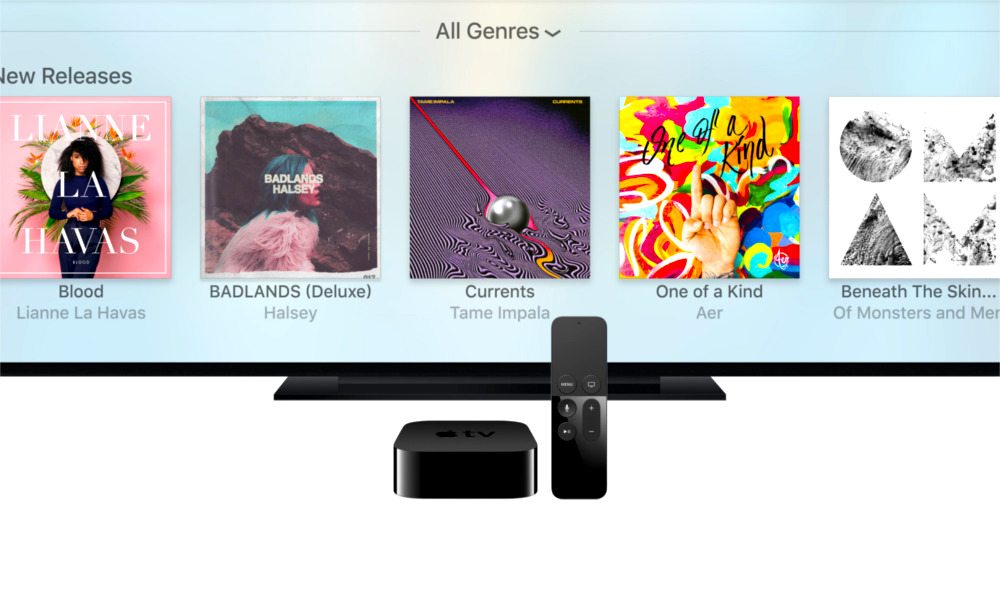5th-Gen Apple TV Rumored to Stream 4K UHD Video, But Is It Enough to Be ‘Revolutionary’?
 Credit: Apple
Credit: Apple
Image via Apple
Toggle Dark Mode
After poaching Amazon’s Fire TV Chief, Timothy D. Twerdhal, to head its television operations division earlier this month, Apple is reportedly gearing up to release an updated, fifth-generation Apple TV set-top box — perhaps as early as later on this year. However, a new report published this morning by Bloomberg’s Mark Gurman appears to cast some doubt on whether or not the forthcoming device will even be viable, especially in regards to the big question, which is ‘will it be enough to compete with even more advanced, lesser-expensive offerings’, such as those from Amazon and Roku.
Twerdhal’s hiring by Apple suggests that the company has a renewed interest in revolutionizing the Apple TV, which has been codenamed “J105” internally, and will be capable of streaming Ultra High-Definition (UHD) content in immersive 4K color and detail, according to the report.
Gurman, however, suggests that while the inclusion of features like 4K streaming are likely to bolster sales of Apple’s standalone set-top box — particularly as users increasingly migrate over to 4K Television sets — features like 4K streaming, in and of themselves, are unlikely to make the 5th-gen Apple TV a “groundbreaking,” iPhone-caliber product. Moreover, several insiders with intimate knowledge of the company’s internal dealings allege that Apple engineers, with each successive refresh, have been “forced to compromise” on the Cupertino-company’s ambitious vision of “revolutionizing the living room.” For instance, Gurman notes, while the original goal of Apple TV was that it would be able to stream live television, effectively replacing the need for a standalone set-top box from your cable company, that in fact never happened — not even to this day — even despite the company’s recent attempts to “streamline” how users access their media content via the Apple TV app for iOS and tvOS.
Introduced by Steve Jobs back in 2006, the first-generation Apple TV was designed merely to stream pre-imported or pre-purchased iTunes video content from a connected Mac to a nearby television set — while the second-generation Apple TV, which was launched over 4 years later in the fall of 2010, kicked things up a notch by allowing users to stream content from the Internet. However, the company’s most recent Apple TV, which launched in October of 2015, actually encompasses a bunch of additional features and upgrades, including the ability to download apps from the App Store, as well as voice functionality made manifest by the Siri-capable remote, which itself enables users to play motion-controlled games on the device.
Even despite these most recent advancements, however, Apple’s Chief Financial Officer, Luca Maestri, in a recent interview acknowledged that sales of his company’s standalone set-top box have decreased, year-over-year, during the 2015 holiday season, extending through the fiscal year 2016. While Cupertino doesn’t reveal how many Apple TV units it sells, eMarketer, an independent research firm, recently reported that the fourth-generation Apple TV has “steadily lost market share” — shrinking from 12.5% of all connected television devices in the September, 2015 quarter, to just 11.9% in January of this year. The firm notes that this slide in market share is in part due to increasing competition from competitors like Google’s Chromecast, Amazon’s Fire TV, and Roku — devices that all offer the same, and sometimes more, functionality than Apple TV, for much less money.
Gurman notes that while the Apple TV isn’t necessarily critical to the company’s bottom-line, however, the device is very much so a vital component of Apple’s extremely profitable services business. However, the Apple TV, itself, has essentially “turned our television sets into a giant iPhone,” in his own words, offering users a consortium of apps that are available to download from the App Store, while not necessarily “revolutionizing” the way users experience and engage with their content.
“That’s not what I signed up for,” says one Apple insider, who requested anonymity so as to freely discuss internal matters. “I signed up for revolutionary. We got evolutionary.”
Even long-time Piper Jaffray analyst, Gene Munster, who covered Apple for more than a decade prior to launching his own firm, ‘Loup Ventures’, echoed those sentiments.
“Apple TV begs the question: Why does Apple do hobbies?” Munster inquired. “Either do it right or don’t do it at all.”
Even despite the criticism, however, many Apple TV users are surely still satisfied with their purchase. Although, at $149 for the base-model, which is over double the cost of similar offerings from the likes of Amazon and Roku, we would certainly hope that the next Apple TV — whenever it launches — would be a bit more consistent with the company’s ambition to innovate, truly “revolutionizing” the way users engage with their content, rather than merely being a device that’s just ever so slightly more capable than the last.
What kind of features would you like to see Apple bring to the Apple TV?
Let us know in the comments!
[The information provided in this article has NOT been confirmed by Apple and may be speculation. Provided details may not be factual. Take all rumors, tech or otherwise, with a grain of salt.]






